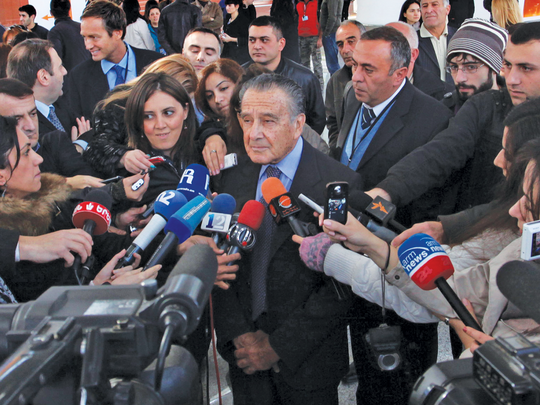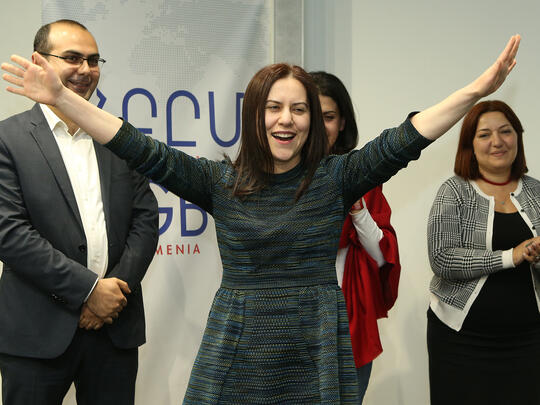Stationed next to a towering float of Mount Ararat, complete with a small replica of Noah’s ark perched on its peak, hundreds of Brazilian dancers, dressed in extravagant and Armenian-inspired costumes, showcased their meticulously rehearsed samba routine in São Paulo’s Sambódromo—a stadium packed with more than 80,000 visitors and over 5,000 dancers, musicians, and performers from around the world.
In March 2019, Brazil’s Carnival debuted an unprecedented Armenian-themed performance, which aired in 140 countries by over 205,000,000 intrigued spectators worldwide in a whirlwind 65 minute performance, some of whom were learning about Armenia for the first time through their television screens. Amidst the blaring music, pounding drums and trumpets, and ebullient energy of performers and onlookers, the Sociedade Rosas de Ouro (Golden Roses) dance school showcased the history and culture of Armenia using traditional larger-than-life headdresses and floats, and vivacious music—fusing ties between two cultures that have never had much of a platform prior to this spectacular event.
While Carnival takes place in different cities throughout Latin America, with celebrations in Argentina, Colombia, Ecuador, Guatemala, Haiti, Peru and Panama, Brazil’s Carnival is arguably one of the most famous, and is often referred to as “The Greatest Show on Earth.” Celebrated five days before Ash Wednesday, the beginning of the 40-day fasting period of Lent—akin to Mardi Gras or even the Armenian celebration of Poon Paregentan, locals claim that the year doesn’t start until Carnival begins, as the country collectively shuts down for five days to make room for festival preparations. Participants range from as young as age nine up to 90 years old, engaging all members of Brazil in this week-long celebration.
The Art of Persuasion
In the midst of the previous Carnival season, André Machado, head of the Rosas de Ouro samba school, or carnavalesco, stumbled upon the theme of his next performance while watching a television episode dedicated to Armenia called “Global Reporter” and claims to have immediately “fallen in love with the richness of the history of Armenia.” The president of the samba school, Angelina Basílio, wasn’t convinced—until she headed to a birthday party for an Armenian friend. After seeing Armenian music and dancing up close and personal, she promptly authorized the “Viva, Hayastan” theme, and their next hurdle was to convince the dancers to tackle this unlikely theme.
According to Machado, “The entire school saw the importance of the theme, especially in regards to the genocide, which we were shocked to learn that the entire world had not recognized. We had another competing theme in mind, but after the Armenian story was chosen, the school embraced it right away.” Though the costume and float designers didn’t portray the Genocide at the carnival as they felt it would be out of place on such an upbeat occasion, the lyrics to the original score made reference to the strength of Armenia and “raising the banner of overcoming.”

After winning over the entire Rosas de Ouro samba school, Machado went into full-research mode—and his exploration of Armenia started right in the heart of São Paulo in Osasco, with the help of travel agent Mariana Papazian and Osasco-native Cesar Sarkis Guludjian. The urban center of Osasco, one of the world’s most dense cities, is a hub for Armenians in Brazil, fully equipped with their own executive board, an active Armenian church, historic monuments, and Armenian restaurants. As a member of the executive board of the Armenian community in Osasco, home to around 5,000 Armenians, Guludjian advised Rosas de Ouro on all things Armenia—from the complex history dating back to prehistoric times to the contemporary culture of Armenia today. While he noted that there was hesitation from the Armenian community, due to the uninhibited nature of Carnival versus the more modest Armenian sensibility, the opportunity to shine a light on Armenian culture outweighed their apprehension.
With all the Armenian bases covered in Brazil, Machado and Basílio could only fulfill their journey through Armenian culture and history with a side trip to Armenia. There they toured local fairs to study Armenian costumes, in addition to visiting larger monuments like Khor Virap, Etchmiadzin, Tatev, and the Mother Armenia monument. “This was the first time I had been on an international trip,” noted Machado, getting emotional while adding, “I owe a huge debt of gratitude to Armenia and the Armenians for sharing their culture with me.”
Cross-Cultural Collaboration
The Rosas de Ouro samba school representatives also collaborated with the Armenian-Brazilian Cultural Economic Forum, an organization dedicated to developing Armenia-Brazil relations, promoting cultural cooperation, and perhaps most surprising, organizing Portuguese classes in Armenia. “Even though the forum was created quite recently, our relationship and love affair with Brazil had been going on for years, both in terms of the Osasco community and our trips to Brazil,” said Ani Gevorgyan, secretary of the forum. With headquarters in Yerevan, the forum visits Brazil at least once a year to maintain cultural relations. Gayane Gevorgyan, who presides over the forum, ensured that Machado and Basílio met with the Armenian Ministry of Foreign Affairs to obtain a well-rounded perspective of Armenia.
After what the Armenian culture endured after the Genocide, it’s inspiring to see that they found a way to go on living, to look ahead and thrive against all odds.
History in Song and Dance
Upon their return to Brazil, Rosas de Ouro announced a competition for Brazilian composers to create the samba music, an important distinction considering the carnival requires that all tunes be original works, pertaining to the theme, and appealing to a global audience. Though a few Armenian composers participated, the winning composition was by a Brazilian ensemble that conducted its own independent research to get a grasp of Armenian culture. Machado arranged for the Armenians of Osasco were present at the headquarters during the judging to ensure the lyrics portrayed Armenia in a respectable yet inspiring manner.
Armenian dance was also integrated into the samba performance. The Kirikian Armenian dance group from Armenia met with the Rosas de Ouro school for a month to teach non-Armenian performers traditional Armenian dances, which served as the opening act for the main event.
Sacred and Sacrilegious
“Carnival preparations start the day after the last Carnival ends,” said Mariana Papazian, who participated in “Viva, Hayastan,” dressed in a golden costume representing the independence of Armenia. Ultimately, because Carnival is a competition, no feather, sequin, or ribbon is spared when handcrafting costumes. Each samba school must choose an engaging theme and construct costumes accordingly‚ headdresses, props, and overstated accessories included, some weighing up to ten pounds or more. The average cost of costumes is valued anywhere between $900 and $10,000 each, which are later sold to outsiders to finance the next year’s costume budget.
Generally, serious religious subjects are strictly forbidden in Carnival events worldwide. Though the São Paulo Carnival was no exception, Rosas de Ouro decided that it was important to feature the Armenian religion in their presentation. Costume designers were faced with the challenge of representing Armenian Christianity in a culturally sensitive manner, while also maintaining typical “Carnival aesthetics,” entailing both skimpy and flamboyant costumes. For “Viva, Hayastan” Machado sketched out costume ideas before visiting Armenia, based on his research, while adding touches of Brazilian motifs and styling. “I had to ‘carnivalize’ the Armenian culture a bit,” he noted. “We had to turn them into conventional Carnival costumes, but they were more tame than those we’ve created in the past.” Machado met with the Armenian church of São Paulo to get approval of his costume designs, and with their blessing, the Rosas de Ouro samba school embarked on their costume design journey.

The floats, or carros alegóricos, and corresponding costumes were broken into four themes: the Splendor of Paradise in the Plains of Ararat, the Cradle of Fascinating Warriors, the Christian Faith, and Armenian Art. More than 500 members of the Armenian community of Brazil paraded with the 2,000 Brazilians. Costumes included golden dresses adorned with letters of the Armenian alphabet, various Armenian warriors with their rivals and occupiers throughout history, and perhaps the most emblematic of both Carnival and Armenia was a glamorous costume dedicated to the Armenian goddess of love Astghik, covered in pink roses as a testament to the Golden Roses samba school and the pink city of Yerevan, famous for its pink-colored tufa stone.
People applauded our efforts and found that we really had a lot to say in a beautiful, moving way...I can’t remember one day when I didn’t see an Armenian cry because they were so proud of the work we did.
Lessons Learned
Machado revealed that competing samba schools were wary of the Rosas de Ouro portraying Armenia in Carnival. “People from other samba schools didn’t think we would be able to pull it off because samba schools usually don’t choose themes representing other countries,” he said, adding, “They couldn’t imagine that we would show Armenian culture because it was so different from ours.” Yet during the parade, Rosas de Ouro impressed the other samba schools and the judges, winning third place in the competition against the 14 other samba schools. “People applauded our efforts and found that we really had a lot to say in a beautiful, moving way…I can’t remember one day when I didn’t see an Armenian cry because they were so proud of the work we did.”
Machado, along with representatives of the samba school, describe this experience as life-changing, adding that there are elements of Armenian culture they hope Brazilians will replicate. “I would love for Brazilians to learn to appreciate our ancestors and our history as the Armenians do, which is not part of our culture.” He added, “Armenians and Brazilians have suffered a lot through history, but in different ways,” referring to Brazil’s complex political and social upheavals over the first two centuries after Brazil was colonized by the Portuguese Empire, along with indigenous tribes (Tupis, Guaranis and Arawaks) and European colonies that were at constant war with each other. “I think the joy we have is the same because we don’t falter. After what Armenian culture endured after the Genocide, it’s inspiring to see that they found a way to go on living, to look ahead and thrive against all odds,” said Machado.

Appropriation vs. Appreciation
The Oxford English Dictionary only recently added the term “cultural appropriation” to its database in 2017 and defined it as “the unacknowledged or inappropriate adoption of the practices, customs, or aesthetics of one social or ethnic group by members of another (typically dominant) community or society.”
On paper, this seems to be precisely what “Viva, Hayastan” represented. Some could say it was even more exploitative considering the Armenian theme was used to win a cash prize. Others might argue that Rosas de Ouro finally gave Armenia a platform in one of the most highly-televised events of the year. By all accounts, the Armenians of Brazil were overwhelmingly touched and all the prouder because of it.
A Lasting Impact
Despite the initial hesitation of the Armenian community, their direct involvement in all aspects of the “Viva, Hayastan” event proved that while their ancestral history cannot be changed, it is possible to view it in a whole new light, this time, from the brilliantly hued lens of Brazilian cultural sensibility.

Papazian noted that “Viva, Hayastan” made its mark in Brazil, not just for the Armenian community of Osasco, but for all organizations involved in its making. “Different institutions can work together to create something beautiful, and after Carnival, all the organizations involved in “Viva, Hayastan” celebration came together and organized a Genocide commemoration for the first time,” Papazian said. “What I loved most about Carnival was that people who didn’t know about Armenia before are now actively participating in Armenian culture, and it makes me proud to be Armenian.”
Organizations like the Armenian-Brazilian Cultural Economic Forum are working to strengthen ties between the two countries, starting with a partnership between the Football Federation of Armenia (FFA) and Brazilian Football Confederation. “Physically, Armenia and Brazil are a long way from each other, and that’s why often we seem to be too mythical to one another, and closer ties seem almost impossible to many,” Gevorgyan noted. “But our goal is to prove that there are no longer distances today, that Armenia and Brazil are even more alike than it may seem, and there’s a lot we can learn from each other.”
Banner photo by Fabio Tito/G1 / Alamy
























